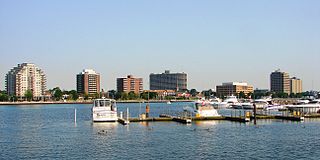
Sarnia is a city in Lambton County, Ontario, Canada. It had a 2021 population of 72,047, and is the largest city on Lake Huron. Sarnia is located on the eastern bank of the junction between the Upper and Lower Great Lakes where Lake Huron flows into the St. Clair River in the Southwestern Ontario region, which forms the Canada–United States border, directly across from Port Huron, Michigan.

Chatham-Kent is a single-tier municipality in Southwestern Ontario, Canada. It is mostly rural, and its population centres are Chatham, Wallaceburg, Tilbury, Blenheim, Ridgetown, Wheatley and Dresden. The current Municipality of Chatham-Kent was created in 1998 by the amalgamation of Blenheim, Bothwell, Camden, the City of Chatham, the Township of Chatham, Dover, Dresden, Erie Beach, Erieau, Harwich, Highgate, Howard, Orford, Raleigh, Ridgetown, Duart, Thamesville, Tilbury East, Tilbury, Wallaceburg, Wheatley and Zone.

Port Colborne is a city in Ontario, Canada that is located on Lake Erie, at the southern end of the Welland Canal, in the Niagara Region of Southern Ontario. The original settlement, known as Gravelly Bay, dates from 1832 and was renamed after Sir John Colborne, a British war hero and the Lieutenant Governor of Upper Canada at the time of the opening of the (new) southern terminus of the First Welland Canal in 1833. The city's population in 2021 was 20,033.

Walpole Island is an island and First Nation reserve in southwestern Ontario, Canada, on the border between Ontario and Michigan in the United States. It is located in the mouth of the Saint Clair River on Lake Saint Clair, about 121 kilometres (75 mi) by road from Windsor, Ontario, and 124 kilometres (77 mi) from Detroit, Michigan.

Point Edward is a village in the Canadian province of Ontario. Adjacent to the city of Sarnia in Lambton County, Point Edward sits opposite Port Huron, Michigan and is connected to it by the Blue Water Bridge, at the meeting point of the St. Clair River and Lake Huron. Formerly called Huron, it was renamed in 1860 to mark the visit by the then Prince of Wales, later Edward VII. Incorporated 1879. In the Canada 2016 Census, the population of Point Edward was 2,037, an increase of 0.1 percent from its 2011 population of 2,034.

Lambton County is a county in Southwestern Ontario, Canada. It is bordered on the north by Lake Huron, which is drained by the St. Clair River, the county's western border and part of the Canada-United States border. To the south is Lake Saint Clair and Chatham-Kent. Lambton County's northeastern border follows the Ausable River and Parkhill Creek north until it reaches Lake Huron at the beach community of Grand Bend. The county seat is in the Town of Plympton-Wyoming.
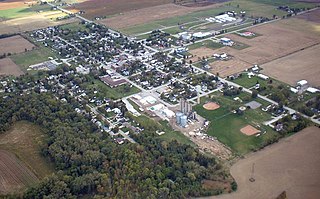
Brigden is a community in the township of St. Clair, Lambton County, Ontario, Canada. The community is located at the crossroads of Courtright Line and Brigden Road, between Kimball to the west and Oil City to the east, and about 20 kilometres (12 mi) southeast of the city of Sarnia. Brigden has a population of about 500 and is the centre of a thriving agricultural district.
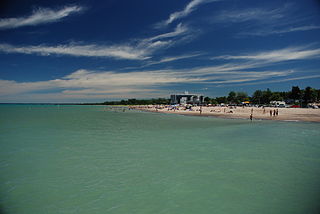
Lambton Shores is a municipality in Lambton County, Ontario, Canada, that is on the southern shores of Lake Huron.

The Township of Ashfield–Colborne–Wawanosh is a municipality in Huron County, Ontario, Canada. It was formed as an amalgamation of the former Ashfield, Colborne and West Wawanosh townships in 2001, in an Ontario-wide local government restructuring imposed by the government of that time. The three former townships now comprise the wards of the amalgamated municipality. Mayor of Dungannon Robert Brindley Jr.

Port Lambton is an unincorporated community in St. Clair Township, Lambton County, Ontario, Canada. According to the latest census, 1084 people live within this community.

Sombra is a village situated on the St. Clair River, in southwestern Ontario, Canada within the municipality of St. Clair Township. In its early days, the village developed out of local transport and agricultural trade via rail and ship and evolved mainly into a summer resort community, serving seasonal residences and summer cottagers through much of its history. The village is now home to mostly permanent residences and commuters supported by larger cities and towns such as Sarnia, Corunna, and Wallaceburg. Each year, in July, the town hosts Sombra Days. This community is served by two elementary schools, several churches and a small service industry. The public school is Riverview Central School. In the recent past, Sombra served as a registered port of entry into Canada by means of a ferry crossing, the Bluewater Ferry from nearby Marine City, Michigan. The village is renowned for quaint specialty shops and fine dining.
The St. Clair Parkway, historically referred to as the River Road, is a scenic parkway in the Canadian province of Ontario. It travels alongside the St. Clair River from west of Wallaceburg to Sarnia, a distance of 41.8 kilometres (26.0 mi). It formed a portion of the route of Highway 40 until it was bypassed by an inland route that opened in the mid-1970s. The St. Clair River Parkway Commission maintained the route from 1966 until 2006, when it was disbanded and responsibility over the parkway transferred to Chatham-Kent and Lambton County, both of which designate the route as County Road 33. The communities of Port Lambton, Sombra, Courtright, Mooretown, Corunna and Froomfield are located along the parkway, all early settlements of the 19th century.

Plympton–Wyoming is a town in the Canadian province of Ontario, located in Lambton County immediately east of Sarnia. It is the seat of the Lambton County Council.
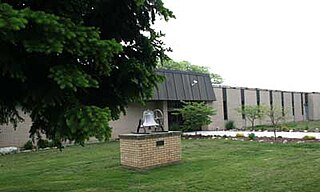
The Lambton Kent District School Board is the school board responsible for public education in Lambton County and Chatham-Kent, Ontario, Canada. Lambton and Kent Counties are made up of numerous small towns and communities situated in Southwestern Ontario, a geographic area surrounded by the Great Lakes.
Courtright is an unincorporated community in St. Clair Township, Lambton County, Ontario, Canada. It is located on the St. Clair River, south of Sarnia. It was incorporated as a village on June 25, 1907, and disincorporated in 1974.
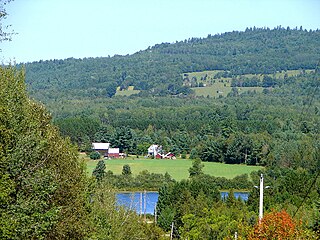
Brudenell, Lyndoch and Raglan is a township in Renfrew County, Ontario, Canada. It was formed on January 1, 1999, through the merger of Brudenell and Lyndoch Township with Raglan Township.

Brooke-Alvinston is a township municipality in the Canadian province of Ontario, located within Lambton County. It was formed on January 1, 2001, when the Township of Brooke was amalgamated with the Village of Alvinston.
Mooretown is a community in the Township of St. Clair, Ontario, Canada, located on the east bank of the St. Clair River. It was first established as Sutherland's Landing.
King's Highway 80, commonly referred to as Highway 80, was a provincially maintained highway in the Canadian province of Ontario. It travelled in an east–west direction south of Sarnia from Courtright to Strathburn. Beginning at the St. Clair Parkway near the shores of the St. Clair River, the route travelled 69.6 kilometres (43.2 mi), intersecting Highway 40, Highway 21 and Highway 79 before ending at Highway 2. In addition to the towns at either terminus, Highway 80 serviced the communities of Brigden, Glencoe and Alvinston. The entire route was and remains two lanes wide.

Corunna is an unincorporated community in St. Clair Township, Lambton County, Ontario, Canada. The site of the community was surveyed by William Beresford in 1823. The community is located approximately 13 kilometres (8.1 mi) south of Sarnia. The community experienced a significant population boom between the 1830s and 1850s, mainly attributed to Scotch-Irish immigration. The community serves as the location of Chemical Valley, a major petrochemical and plastics manufacturing facility.





















